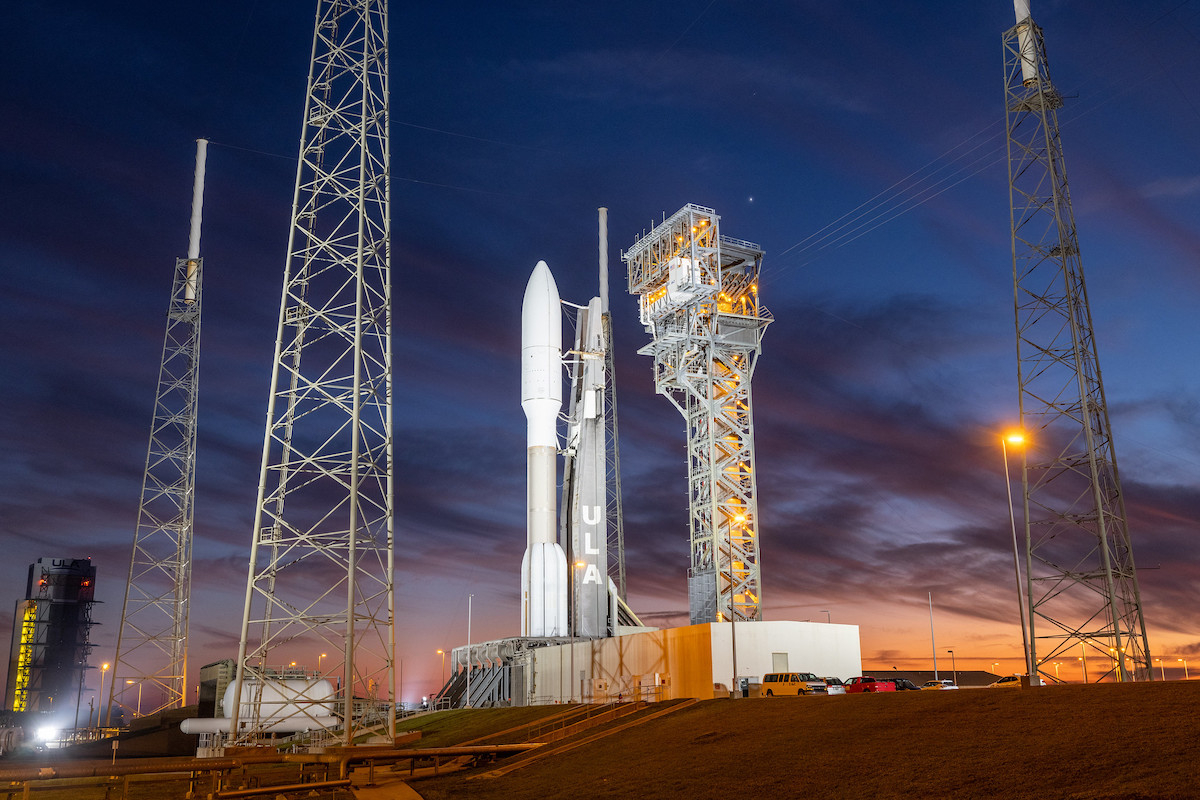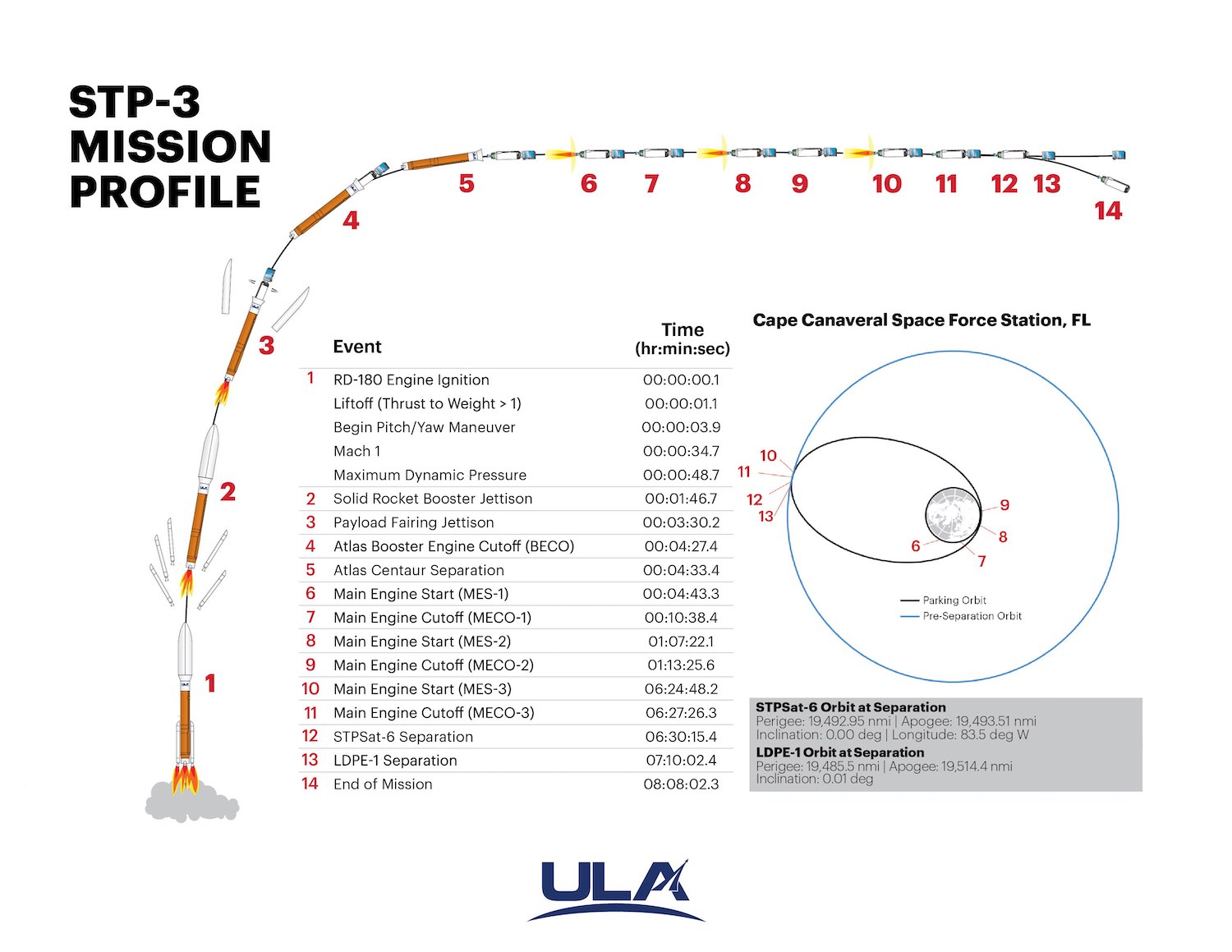Space News & Blog Articles
ULA to set rocket endurance record on next launch
 An Atlas 5 rocket stands on launch pad 41 ahead of the STP-3 mission. Credit: United Launch Alliance
An Atlas 5 rocket stands on launch pad 41 ahead of the STP-3 mission. Credit: United Launch Alliance
United Launch Alliance’s Atlas 5 rocket will set an endurance record after liftoff from Cape Canaveral Tuesday, targeting the delivery of two U.S. military tech demo satellites directly into a geosynchronous orbit more than 22,000 miles over the equator.
The Atlas 5’s Centaur upper stage, propelled by an Aerojet Rocketdyne RL10 engine, will maneuver the two Space Force satellites into a geosynchronous orbit with a sequence of three rocket burns over the course of six-and-a-half hours.
The two satellites host an array of technological prototypes and experiments. Military engineers will test their readiness for use on future operational space missions.
The launch is sponsored by the military’s Space Test Program, which oversees many of the Defense Department’s experimental space missions. The larger of the two satellites on the Atlas 5 rocket, named STPSat 6 and built by Northrop Grumman, hosts a NASA laser communications experiment and a payload for the National Nuclear Security Administration designed to detect nuclear detonations to verify international treaty compliance.
The military hasn’t disclosed specifics for other experiments on the mission, but officials said they generally will test technologies related to space domain awareness, space weather monitoring, and communications.
A rideshare satellite named the Long Duration Propulsive ESPA, or LDPE 1, also is riding to orbit on the Atlas 5 rocket. It is mounted to the rocket below STPSat 6 inside the 17.7-foot (5.4-meter) diameter payload fairing.
LDPE 1 hosts its own technological experiments, and will have its own propulsion system to maneuver in space. The spacecraft is capable of releasing small satellites into orbit. When asked, military officials would not confirm whether the LDPE 1 spacecraft’s experiments include any deployable smallsats.
The mission is set to begin with a blastoff from launch pad 41 at Cape Canaveral Space Force Station at 4:04 a.m. EST (0904 GMT) Tuesday, the opening of a two-hour launch window.
The destination? A nearly circular geosynchronous orbit hugging the equator.
Most satellites heading to such an orbit get dropped off in an egg-shaped transfer orbit. That requires the spacecraft to use its own propulsion resources to circularize at an operational altitude over the equator.
Some launches deploy their satellites directly into geosynchronous orbit. ULA’s Atlas 5 and Delta 4 rockets have accomplished this feat before, but the launch Tuesday will set a new record with the Centaur upper stage.
“This is a highly complex orbital insertion that requires three Centaur burns and precise navigation, a capability unique to the Atlas t. This is our longest mission to date at seven hours and 10 minutes until final spacecraft separation,” said Gary Wentz, ULA’s vice president of government and commercial programs.
 The launch timeline for the STP-3 mission. Credit: United Launch Alliance
The launch timeline for the STP-3 mission. Credit: United Launch Alliance
ULA’s 196-foot-tall (59.7-meter) Atlas 5 rocket will fly in its most powerful configuration with five strap-on solid rocket boosters clustered around the bottom of the first stage.
The solid-fueled boosters will provide the majority of the 2.6 million pounds of thrust to drive the Atlas 5 launcher off the pad on a trajectory east from Cape Canaveral. A kerosene-burning RD-180 engine will power the first stage core.
The mission will mark the 90th flight of an Atlas 5 rocket since 2002, and the 12th in the “551” configuration with five solid rocket boosters and a 5.4-meter (17.7-foot-diameter) payload fairing.
The five boosters will consume their pre-packed solid fuel in less than two minutes, then release to fall into the Atlantic Ocean. The Atlas 5’s payload shroud will jettison three-and-a-half minutes after liftoff, then the RD-180 main engine will shut down four-and-a-half minutes into the flight.
The Centaur upper stage’s RL10 engine will ignite for a six-minute burn to reach a parking orbit, then reignite for another six-minute burn at T+plus 1 hour, 7 minutes, to begin the process of boosting the STP-3 payloads to a higher altitude.
A third and final Centaur maneuver is planned to begin at about T+plus 6 hours, 25 minutes, to steer the STP-3 payloads into their targeted circular orbit over the equator at an altitude of about 22,400 miles (36,100 kilometers).
That distance is just above geostationary altitude, where satellites circle Earth at the same rate of the planet’s rotation. STPSat 6 will settle into a parking spot within visibility of the Americas and the Pacific Ocean, while LDPE 1’s destination and final orbital position have not been disclosed by the Space Force.
ULA says the Atlas 5 mission comes with several firsts.
One of those is the first flight of a composite 5-meter payload fairing produced using a new manufacturing process called “out of autoclave,” a simpler method of curing carbon fiber that saves money, time, and weight. The payload shroud looks the same as previous Atlas 5 nose cones, and was produced by the Swiss-based company RUAG Space, the same company that built fairings for previous Atlas 5 missions.
But the out of autoclave fairing was manufactured by RUAG at a new fabrication facility located at ULA’s rocket factory in Decatur, Alabama. Previous Atlas 5 fairings from RUAG were built at the company’s production site in Switzerland, alongside similar composite shrouds for Europe’s Ariane 5 rocket.
ULA’s next-generation Vulcan rocket will use the same payload fairing design. The company, a 50-50 joint venture between Boeing and Lockheed Martin, wants to get flight experience with the fairing before the first Vulcan test launch next year.
The STP-3 mission also debuts an in-flight power system ULA says will supply electricity to the batteries on the STPSat 6 and LDPE 1 satellites during the long coast to their deployment altitude. The system will ensure the spacecraft have fully charged batteries when they separate from the Centaur upper stage, according to ULA.
There’s also a GPS enhanced navigation capability making its first flight on the STP-3 mission, allowing the Centaur to more precisely inject its satellite passengers into their targeted orbits.
ULA is also flying a new booster rate gyro unit, a lower-cost, lower-weight alternative to a previous system that uses commercial inertial measurement units in the rocket’s guidance system.
This email address is being protected from spambots. You need JavaScript enabled to view it. the author.
Follow Stephen Clark on Twitter: @StephenClark1.
When you subscribe to the SpaceZE News Feed, we will send you an e-mail when there are new updates on the site so you wouldn't miss them.

